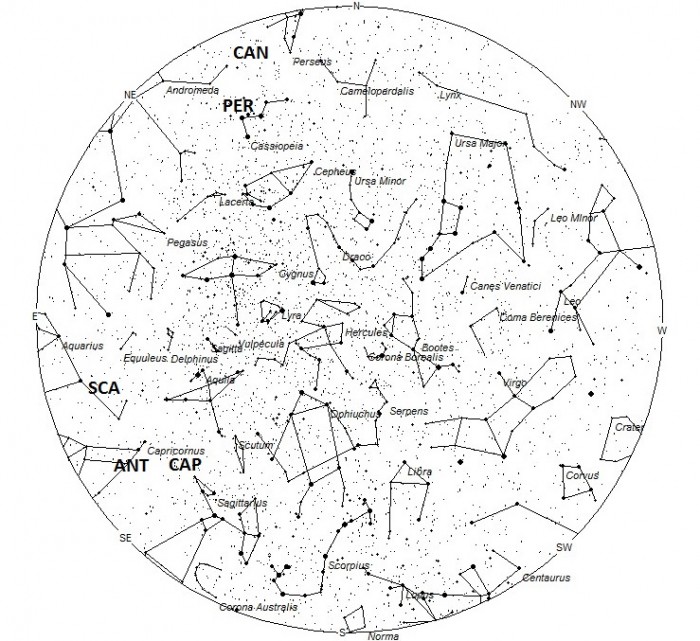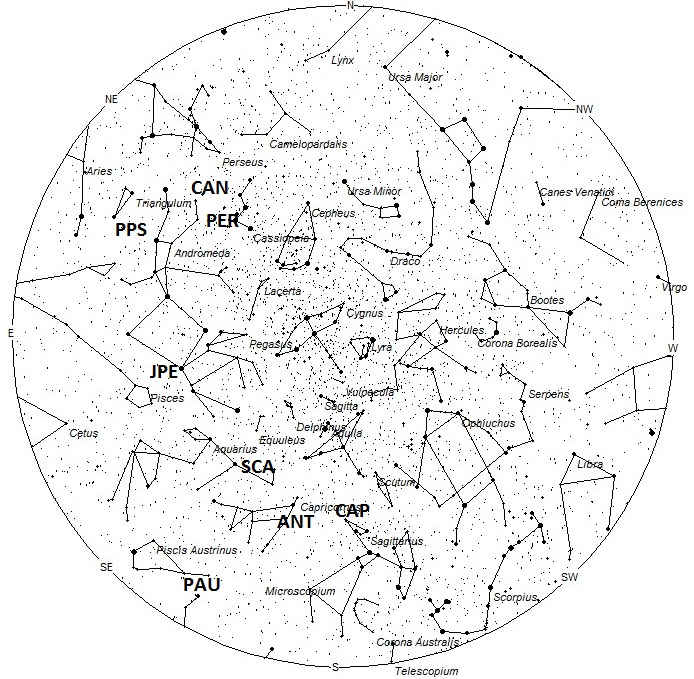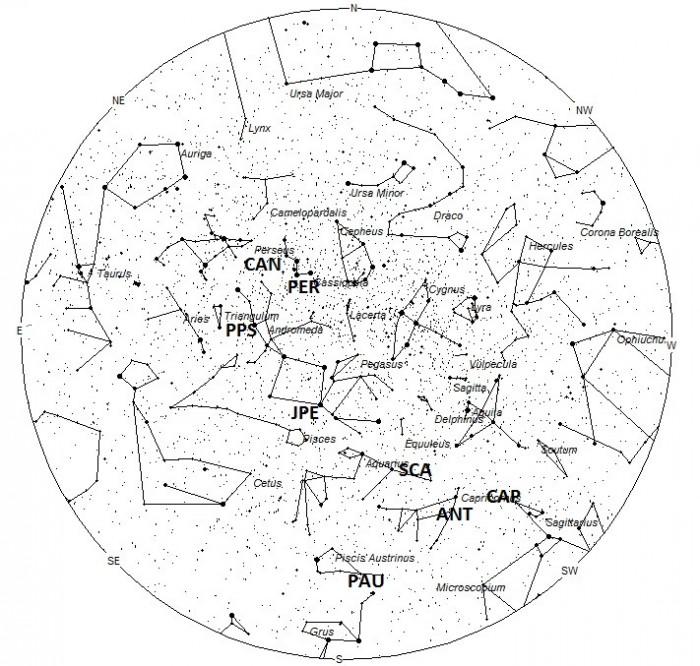During this period the moon reaches its first quarter phase on Monday July 15th. At this time the moon is located ninety degrees east of the sun and will be in the sky until midnight local daylight time (LDT) as seen from mid-northern latitudes. As the week progresses the waxing gibbous moon will set later during the morning hours, interfering with morning observations. The estimated total hourly meteor rates for evening observers this week is near three no matter your location. For morning observers the estimated total hourly rates should be near fourteen as seen from mid-northern latitudes and thirteen as seen from mid-southern latitudes. The actual rates will also depend on factors such as personal light and motion perception, local weather conditions, alertness and experience in watching meteor activity. Evening rates are reduced during this period due to moonlight.
The radiant (the area of the sky where meteors appear to shoot from) positions and rates listed below are exact for Saturday night/Sunday morning July 13/14. These positions do not change greatly day to day so the listed coordinates may be used during this entire period. Most star atlases (available at science stores and planetariums) will provide maps with grid lines of the celestial coordinates so that you may find out exactly where these positions are located in the sky. A planisphere or computer planetarium program is also useful in showing the sky at any time of night on any date of the year. Activity from each radiant is best seen when it is positioned highest in the sky, either due north or south along the meridian, depending on your latitude. It must be remembered that meteor activity is rarely seen at the radiant position. Rather they shoot outwards from the radiant so it is best to center your field of view so that the radiant lies at the edge and not the center. Viewing there will allow you to easily trace the path of each meteor back to the radiant (if it is a shower member) or in another direction if it is a sporadic. Meteor activity is not seen from radiants that are located below the horizon. The positions below are listed in a west to east manner in order of right ascension (celestial longitude). The positions listed first are located further west therefore are accessible earlier in the night while those listed further down the list rise later in the night.
The following shower are expected to be active this week:
Activity from the Alpha Capricornids (CAP) begins next week from a wide radiant located at 19:48 (297) -14. This position lies in northeastern Sagittarius, seven degrees west of the third magnitude star known as Dabih (Beta Capricornii). The radiant is best placed near 0100 local daylight time (LDT), when it lies on the meridian and is highest in the sky. Current rates should be less than one per hour no matter your location. Don’t confuse these meteors with the antihelion meteors, which have a radiant just to the east. Both radiants need to be in your field of view to properly sort these meteors. With an entry velocity of 25 km/sec., most activity from this radiant would be slow, a bit slower than the anthelions. This radiant is well seen except for far northern latitudes where it remains twilight all night long and the radiant does not rise as high into their sky.
The center of the large Anthelion (ANT) radiant is currently located at 20:16 (304) -18. This position lies in western Capricornus, five degrees south of Dabih (Beta Capricornii). Due to the large, oval-shaped radiant, activity from this source may also be seen coming from eastern Sagittarius, southern Aquila, Microscopium, western Aquarius, Pisces Austrinus, as well as Capricornus. These meteors may be seen all night long but the radiant is best placed near 0200 LDT when it lies on the meridian and is highest in the sky. Rates at this time should be less than one per hour as seen from the Northern hemisphere and one per hour from south of the equator . With an entry velocity of 30 km/sec., the average Anthelion meteor would be of slow velocity.
The Sigma Capricornids (SCA) were discovered by Zdenek Sekanina and are active for a month lasting from June 19 through July 24. Maximum activity occurred on June 27th. The radiant is currently located at 21:12 (318) -05. This area of the sky is actually located in western Aquarius, five degrees west of the third magnitude star known as Sadalsuud (Beta Aquarii). The radiant is best placed near 0300 LDT when it lies on the meridian and is highest in the sky. Rates at this time should be near one per hour no matter your location. With an entry velocity of 42 km/sec., the average Sigma Capricornid meteor would be of medium velocity. This velocity is significantly faster than the stronger Alpha Capricornids, which appear from the same general area of the sky during the second half of July.
The Piscids Austrinids (PAU) are a minor shower not well seen from the northern hemisphere. This radiant is active from July 15 through August 10. Maximum activity occurs on July 28 when the zenith hourly rate (ZHR) may reach five. These rates are only seen from the southern hemisphere where the radiant passes overhead. From mid-northern latitudes, rates of one per hour at maximum are usually seen. The radiant is currently located at 22:04 (331) -36. This position lies in southwestern Piscis Austrinus, two degrees northeast of the third magnitude star Al Dhanab (Gamma Gruis). The radiant is best placed near 0300 LDT, when it lies highest in the sky. With an entry velocity of 35km/sec., most activity from this radiant would be of average velocities.
The July Pegasids (JPE) were discovered by Peter Jenniskens during his study of annual streams during the late 80’s and early 90’s. This source is active with low rates during most of July with maximum activity occurring on the 10th. The radiant is currently located at 23:20 (350) +12. This area of the sky lies in southern Pegasus, four degrees southeast of the second magnitude star Markab (Alpha Pegasi). This radiant is best placed during the last dark hour before dawn, when it lies highest above the horizon in a dark sky. Rates at this time should be near one per hour no matter your location. With an entry velocity of 68 km/sec., the average July Pegasid meteor would be of swift speed.
Activity from the Perseids (PER) may be seen starting this weekend and lasting throughout the remainder of July and nearly all of August. The radiant is currently located at 00:20 (005) +50. This position lies in southern Cassiopeia, seven degrees southwest of the second magnitude star Shedar (Alpha Cassiopeiae). The radiant is best placed during the last hour before the start of morning twilight when it lies highest in a dark sky. Since the maximum is not until August 12th, current rates would be less than one per hour, no matter your location. Activity from this source is not visible south of 40 degrees south latitude. With an entry
velocity of 61 km/sec., most activity from this radiant would be swift.
The Phi Piscids (PPS) were mistakenly listed as the Pi Piscids (PPI) in the last couple of outlooks. The Phi Piscids were discovered by Dr. Peter Brown and his Canadian Meteor Orbit Radar (CMOR) team. Activity is found from this source throughout June and July. Maximum activity occurred on July 1st. The radiant is currently located at 01:24 (021) +30. This area of the sky is located in on the Pisces/Triangulum border, very close to the position occupied by the famous “pinwheel Galaxy” also known as M33. The third magnitude star Ras al Muthallah (Alpha Trianguli) lies four degrees to the southeast. The radiant is best placed near 0300 LDT when it lies on the meridian and is highest in the sky. Rates at this time should be near two per hour as seen from the northern hemisphere and one per hour as seen from south of the equator. With an entry velocity of 69 km/sec., the average Phi Piscid meteor would be of swift velocity.
The c-Andromedids (CAN) was discovered by Sirko Molau and Juergen Rendtel using video data from the IMO network. Activity from this source is seen from June 26 though July 20 with maximum activity occurring on July 10. The radiant currently lies at 02:12 (033) +51, which places it in extreme southwestern Perseus, ten degrees north of the famous second magnitude double star Almach (Gamma Andromedae). This area of the sky is best seen during the last dark hour before dawn when the radiant lies highest in a dark sky. Observers in the northern hemisphere are better situated to view this activity as the radiant rises much higher in the sky before dawn as seen from northern latitudes. Current rates would be one shower member as seen from the northern hemisphere before dawn and less than one per hour for observers situated south of the equator. With an entry velocity of 60 km/sec., the average meteor from this source would be of swift velocity.
As seen from the mid-northern hemisphere (45N) one would expect to see approximately nine sporadic meteors per hour during the last hour before dawn as seen from rural observing sites. Evening rates would be near two per hour. As seen from the mid-southern hemisphere (45S), morning rates would also be near nine per hour as seen from rural observing sites and two per hour during the evening hours. Locations between these two extremes would see activity between the listed figures. Evening rates are reduced due to moonlight.
The table below presents a list of radiants that are expected to be active this week. Rates and positions are exact for Saturday night/Sunday morning.
| SHOWER | DATE OF MAXIMUM ACTIVITY | CELESTIAL POSITION | ENTRY VELOCITY | CULMINATION | HOURLY RATE | CLASS |
| RA (RA in Deg.) DEC | Km/Sec | Local Daylight Time | North-South | |||
| Alpha Capricornids (CAP) | Jul 30 | 19:48 (297) -14 | 25 | 01:00 | <1 – <1 | II |
| Anthelions (ANT) | – | 20:16 (304) -18 | 30 | 02:00 | <1 – 1 | II |
| Sigma Capricornids (SCA) | Jun 27 | 21:12 (318) -05 | 42 | 03:00 | 1 – 1 | IV |
| Pisces Austrinids (PAU) | Jul 28 | 22:04 (331) -36 | 35 | 04:00 | <1 – <1 | II |
| July Pegasids (JPE) | Jul 10 | 23:20 (350) +12 | 68 | 05:00 | 1 – 1 | IV |
| Perseids (PER) | Aug 12 | 00:20 (005) +50 | 61 | 06:00 | <1 – <1 | I |
| Phi Piscids (PPS) | Jul 01 | 01:24 (021) +30 | 69 | 07:00 | 2 – 1 | IV |
| c-Andromedids (CAN) | Jul 10 | 02:12 (033) +51 | 60 | 08:00 | 1 – <1 | IV |
Writing an essay can be one of the most interesting things for any university or college students. It offers a lot of learning opportunities even though it is one of the toughest things that you could engage in. Normally, many students who find their time a little bit trick and occupied always find the use of custom essay writing services to be of great importance to them and many have actually been able to save on their time and carry out on other important projects which always demand a lot of attention and time in their academic life. It is not an easy thing to balance both the demands of custom essay writing and those of other parts of the college life and not unless you are a very keen student, it will always stretch your wits. Choosing an custom essay writing service provider sometimes can be tricky and you will need to take your time when looking for one.
 American Meteor Society
American Meteor Society



on July 19 2013 approximately 4:38 a.m. I had seen at least 4 “shooting stars”
It was a clear early morning as i was out for an early walk. Everywhere i looked 4 sighting in a 20 minute time span.
I live in Kalamazoo Mi
I was so pleased and very excited to see this feature of nature.